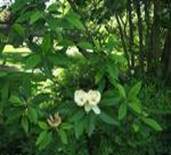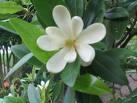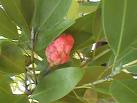| Kingdom | Plantae |
| Unranked | Angiosperms |
| Unranked | Magnoliids |
| Order | Magnoliales |
| Family | Magnoliaceae |
| Genus | Magnolia |
| Species | M. virginiana |
| Binomial name | Magnolia virginiana |
Other Common Names:
The other common names for the magnolia tree are CucumberTree, Sweetbay magnolia, Magnoliae cortex, Blue Magnolia, Swamp Sassafras and Magnolia Tripetata.
History
The genus is named after French botanist Pierre Magnol, from Montpellier. In 1703 Charles Plumier (1646-1704) described a flowering tree from the island of Martinique in his Genera. He gave the species, known locally as 'Talauma', the genus name Magnolia, after Pierre Magnol. The English botanist William Sherard, who studied botany in Paris under Joseph Pitton de Tournefort, a pupil of Magnol, was most probably the first after Plumier to adopt the genus name Magnolia. These were the first works after Plumier's Genera that used the name Magnolia, this time for some species of flowering trees from temperate North America.

Description
Magnolia virginiana is a medium sized tree which grows up to 27 meters tall with a diameter of around 1.2 meters. All its members are handsome, with luxuriant foliage and rich flowers which are white, pink, purple, green, or yellow. The flowers are followed by showy red or pink fruits displaying red, orange, or pink seeds, each of which hangs from the fruit by a thread-like strand.


Range
Magnolia virginiana is native from Massachusetts to Florida and Texas. It is abundant in coastal regions of Louisiana, Mississippi, and Alabama. Magnolia virginiana reaches a maximum height of 60 feet and a trunk diameter of about 20 inches in its native coastal swamps from North Carolina to Florida and Louisiana.
Habitat
Magnolia Virginian performs well in a wide range of soil conditions from wet to slightly dry. It is common in moist, acid soils close to wet places such as ponds, streams, and cutover lands. Although Magnolia virginiana is a swamp or bog tree, it will grow well in fertile, moist well drained soils. It is found mostly in full sunlight to partial shade elevation.
Cultivation
Magnolias grown from seed often vary in crown structure, size, vigour, and flower and foliage characteristics. Seed-grown plants usually take much longer to flower than asexually propagated plants. Magnolia fruits are 2 to 6 inches long and ripen in late summer to late fall. When mature, individual follicles in the fruit split to expose red or orange seeds. Fruits should be promptly harvested when seeds are mature. Alternatively, fruits with immature seeds may be ripened in a warm room. Seeds should be macerated in water to remove the red seed coat and fleshy pulp. Soaking macerated seeds in water for a few days may help in pulp removal. Freshly cleaned seeds may be sown right away but germination may be improved if seeds are stratified at 40°F for 2 to 4 months. Seeds may be stored for several years in sealed containers at 32 to 40°F.
Cutting propagation is preferred for most magnolias. However, rooting potential of cuttings varies considerably among cultivars as well as among species. Magnolia denudata, M. acuminata, and M. grandiflora are considered difficult to root from cuttings. Soft to semi-hardwood cuttings should be taken from juvenile plants whenever possible. Wounding may be beneficial. Cuttings should be treated with 5,000 to 10,000 ppm IBA and placed under intermittent mist. Cuttings usually root within 6 to 12 weeks. Layering is the ancient, traditional way of propagating magnolias. In its simplest form, branches are bent and pegged to the ground in late winter or early spring. A slit or cut is usually made in the buried portion of the stem. The terminal portion of the bent branch should be staked vertically. Magnolias may also be air-layered. Layered plants can be cut from the mother plant 1 to 2 years later.
Flowering Season
Cream flower which is small, globular and very fragrant. The flowers extend two to three inches across and are found on the tree from early to late summer.
Pests and Diseases
Magnolias are less susceptible to pests than many other ornamentals. Soft and armored scales are common in woods and landscapes and can occasionally damage plants. Magnolia root borer (Euzophera magnolia is) has caused problems in nurseries but is not a significant landscape problem. Several nematodes can infest magnolia roots. Wildlife eats the seeds and flower tepals.Several diseases affect magnolias, but none are serious. Stem cankers, powdery mildew and many different leaf spots are occasional problems. Root and wood rots occur as well as a verticillium wilt.
Parts Used


Bark of stem, leaves and the roots are the most commonly used parts of the magnolia tree for its commercial and medicinal purposes.
Medicinal Applications


• Magnolia is a mild diaphoretic, tonic, and aromatic stimulant.
• It is used in rheumatism and malaria and is contra-indicated in inflammatory symptoms.
• Historically been used as a substitute for quinine in the treatment of malaria.
• At times the cones are steeped in spirits to make a tonic tincture.
• The bark, if chewed as a substitute for tobacco, is said to cure the habit.
• A tea made from the fruit is a tonic, used in the treatment of general debility and was formerly esteemed in the treatment of stomach ailments.
• A warm infusion is laxative and sudorific, a cold one being antiperiodic and mildly tonic
Commercial Applications


• Magnolia virginiana is used in landscaping because of its form and its fragrant ivory flowers.
• An essential oil from the flowers has been used in the manufacture of perfumes.
• It can be used for furniture, paneling, veneer, pulp, tool handles, cabinet work, and for crates.
• Used for furniture, broom handles, bowls and light woodenware articles.
• The leaves are used as a condiment in cooking and are also used to make tea.

There is an affinity between the magnolia and the Wheel of Fortune card. This is one of those references which may have arisen at the turn of the last century. One may work with the extracted oil or even place a magnolia bloom in a bowl of water when meditating upon this card. Magnolia is widely reputed to enhance conjugal felicity and fidelity. The whole leaves are sewn into the mattress as a faithful marriage conjuration. Jealous wives who do not trust the beneficent power of magnolia have been known to add to the leaves a Mojo in which they conceal the so-called "nine-knot measure" of their husband's nature. This, they claim, will hoodoo his nature so he will be unable to perform for any other woman. The Tennessee musician Will Batts protested against this wicked custom in his song "Country Woman," recorded in Memphis in 1933.